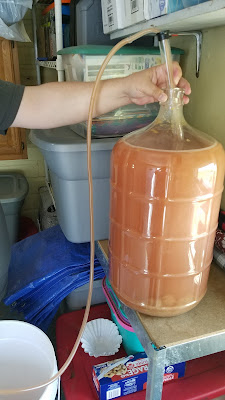At an author signing in 2019, I bought a book called Wild Wine Making because I thought it sounded interesting. The author was a bit... well, odd, but very proud of his book. As usual, when I attend an author event, I end up spending more money on purchasing books than I make selling them. But, the book looked interesting and the author assured me it was incredibly easy, so I bought a book for myself and one for a friend.
Jay and I flipped through the book and decided to try one of the recipes for our Christmas Eve gifts. Each year, we make something different as family gifts for Christmas Eve. Last year was two different types of bacon salt; the year before that I canned homemade marinara; one year we made homemade ice cream, etc.
We discussed getting a batch started after we returned from SHOT Show, but we were slackers and didn't actually get around to buying the equipment until the shut-down in mid-March. Suddenly, it was the perfect time to get around to doing the projects we'd been putting off.
We ordered the equipment, and once it arrived we purchased the ingredients for a peach-blackberry wine. Almost immediately we realized that the "incredibly easy" wine recipes were anything but. If we had any experience at all with wine making prior to this, it might have been easy, but we were complete noobs. Luckily, the information we couldn't find in the book on how to make wine was easily found on YouTube. By cobbling the information together, we came up with a plan and turned our mudroom into a winery.
 |
| 5/3/20 Day one |
 |
| 5/4/20 Day two |
 |
| 5/4/20 The yeast was definitely working |
During the primary fermentation process, we stirred the nastiness (it's actually called "must") twice a day for a couple of weeks, adding sugar water as needed, until the yeast slowed down. After that, it was time to strain out the fruit and move the wine to the secondary fermentation vessel. In the book, the author says that a fermentation bag for the fruit is not necessary. Let me tell you, it might not be necessary, but it'll damn sure make your life easier. It took a very long time, and a lot of swearing to strain out the fruit. We made a huge mess, but finally got the wine moved to the secondary fermentation vessel.
 |
| Getting a large pot ready for the first straining |
 |
| Removing the fruit and straining out the juice |
 |
| Straining the juice again into the secondary fermentation vessel |
 |
| Not having the right equipment will make the process tedious |
 |
| 5/14/20 Secondary fermentation started |
Once it was all moved from the primary fermentation vessel (the 6-gallon bucket) into the secondary fermentation bottle (the glass bung (yes, that's its real name)), we fit it with an airlock that allowed the yeasts' gasses to escape, and covered with a cardboard box to keep it cool and dark. If we had a basement, that would have been a better option, but the cardboard box worked remarkably well.
The next day, we checked and saw the yeast were happily chugging along, doing their job.
A couple of days later we "racked" the wine, siphoned it to remove the sediment. At that stage, it was still pretty cloudy and we were still figuring out what the hell we were doing, but we got it racked.
After we racked it the first time, wine making got markedly easier. All we had to do was rack it every few weeks to remove the wine from the sediment. Racking the wine is the perfect time to taste it, and it was much better than I anticipated each time. The problem was, each time we racked it, we lost a bit of volume, so that by the second-to-last time we racked it, we'd lost a full gallon. There was nothing in the book about what to do, but we were under the impression the bung needed to be kept full to decrease the amount of oxygen the wine was exposed to. Not knowing what to do, we decided to add more sugar water to make up the volume.
The next time we racked the wine, it was much sweeter than previously. I complained that it was sweet. Jay looked at me and said, "it's a dessert wine" and thus the idea was born for a Grease-based theme for the wine.








